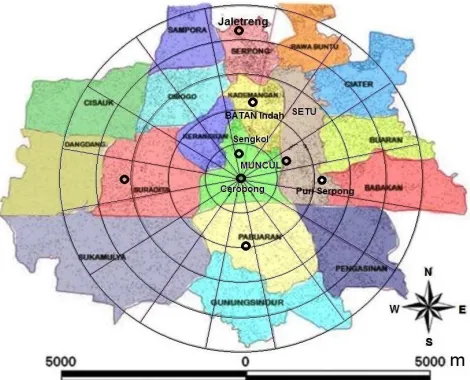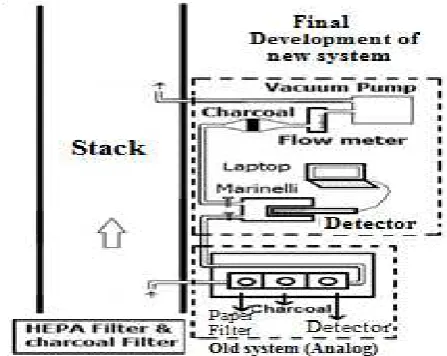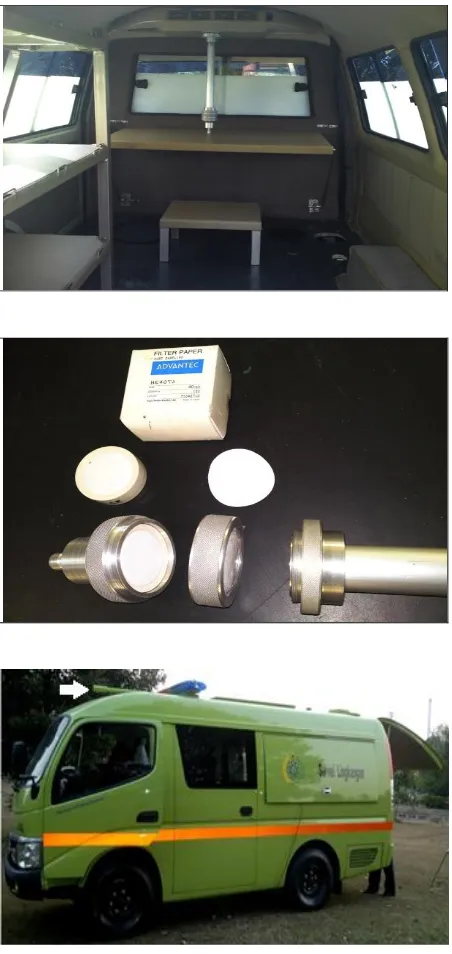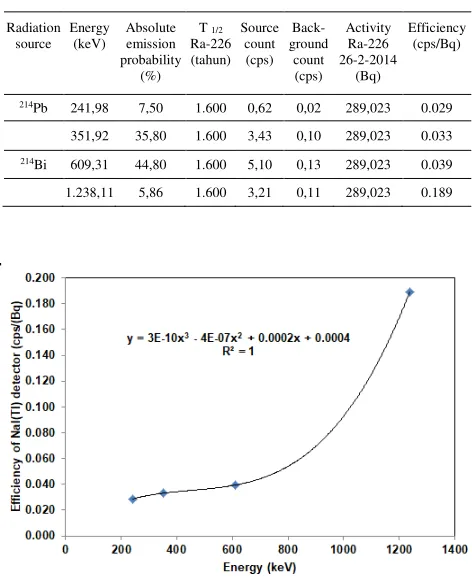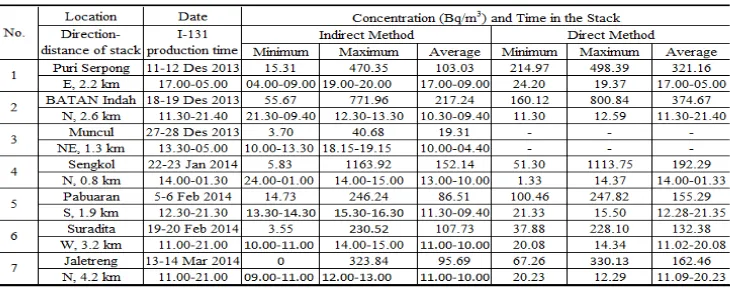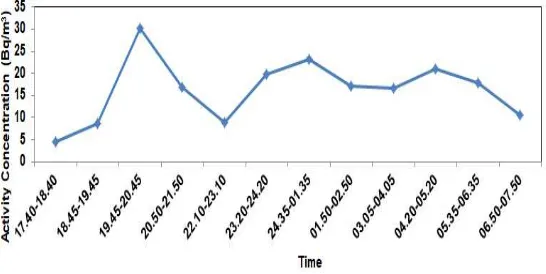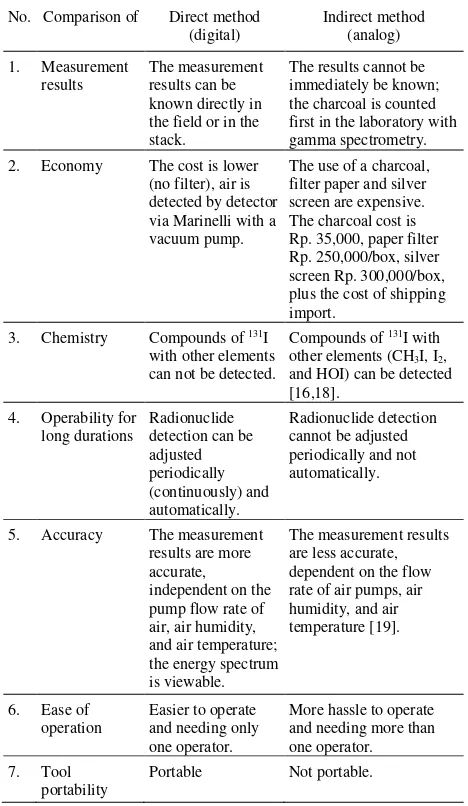Comparative Analysis of Direct and Indirect
131
I Measurement Methods from the Stack
to Outdoor
G. Suhariyono
*and Bunawas
Center for Radiation SafetyTechnology and Metrology,National Nuclear Energy Agency , Jl. Lebak Bulus Raya, No. 49, Jakarta 12440, Indonesia
A R T I C L E I N F O A B S T R A C T
Article history:
Received 31 October 2016
Received in revised form 17 May 2017 Accepted 22 May 2017
Keywords: Stack Iodine-131
131I
Outdoor Charcoal Environment In-situ Dispersion Direct Indirect
The radioisotope production facility at PUSPIPTEK Serpong produces and processes 131I that can disperse to the settlements (community) and the environment
around the Serpong Nuclear Area (SNA). 131I is produced routinely for medical
uses in hospitals and pharmacies, for both domestic uses and export. 131I is a beta
and gamma emitting radioactive material and can cause thyroid cancer. The problem was that there was so far no research and in-depth assessment of the aerial dispersion of 131I radioactivity emitted from the radioisotope production stack
to the environment at actual conditions. The research was conducted through simultaneous measurement of 131I radioactivity in the stack of the 131I radioisotope
production facility, Serpong, and outdoor in house courtyards around SNA in normal condition (no accident) based on the variations of the distance and wind direction. Direct measurements were carried out with a portable in-situ NaI(Tl) detector at outdoor, and with a LaBr3 detector in the stack. Indirect measurements
were carried out by using charcoal filter and vacuum pump in the stack and outdoor. The direct measurement method has many advantages over the indirect measurement. The direct measurement method was found to be more accurate, less expensive, easier to operate, needing just one operator in its implementation, portable, and can be operated continuously and for long durations. The overall activity concentrations of 131I on average obtained by either direct or indirect
method were still below the upper limit of 131I activity concentration in the air
(530 Bq/m3) stipulated by the Regulation of the Chairman of BAPETEN (Perka
BAPETEN) No. 7/2013.
© 2017 Atom Indonesia. All rights reserved
INTRODUCTION
The 131I radionuclide is the one of the most
common radionuclides released from a nuclear accident [1-3]. 137Cs is the second most released
radionuclide, under 131I. Therefore, a 131I release is
to be anticipated in the event of a nuclear emergency. From the experiences from other countries, for example, it was found that the activity of the 131I radionuclide is released from nuclear
accidents at the Oak Ridge laboratory (Tennessee,
USA) in 1944-1956 was a much as 0.30 to 1.55 PBq, while at Hanford (Washington State,
Corresponding author.
E-mail address: g_suhariyono@batan.go.id DOI: https://doi.org/10.17146/aij.2017.756
USA) from 1944 to 1972 it was 27.83 PBq, and in
Nevada, USA, from 1952 to 1970 was as much as 5,550 PBq. Furthermore, the Three Mile Island
accident in 1979 released as much as 555-777 GBq, the Chernobyl (Ukraine) accident in 1986 released 1,850 PBq, the Savannah River (South Carolina,
USA) operation in 1955-1990 released as much as 2.22 PBq, and the Fukushima (Japan) accident in March 2011 released as much as 400 PBq [1- 6].
Radioiodine (131I) is one of the radioactive
substances sufficiently significant to get attention, because it is volatile with a probability of 81.21 % of its formation greater than the other radioiodine isotopes [1]. Based on EPA RadNet measurement, 81 % of ambient 131I was detected in the gas phase
and 19 % was detected in the particle phase [3].
Atom Indonesia
The thyroid gland is the most critical human organs affected by 131I [7]. If the 131I is located in the human
body, then the 131I will enter the thyroid through the
metabolism of the body carried by the blood [8]. The chemical properties of 131I are similar with
those of stable iodine, so 131I can damage the thyroid
gland and damage the health [9,10]. 131I that is
dispersed from the stack to the environment can also impact the economy of the society [11].
A radioisotope production facility is located in the Research Center for Science and Technology (PUSPIPTEK - Pusat Penelitian Ilmu Pengetahuan
dan Teknologi in Indonesian) in Serpong, Indonesia.
This facility produces several radioisotopes for both domestic and export purposes; one of those radioisotopes is 131I that was routinely produced for
medical purposes in hospitals and pharmacies. The experiment presented here ran from December
2013 to March 2014.This facility is located in the Serpong Nuclear Area (SNA) that is surrounded by dense residential population. Residents in the area of 5 km radius from PUSPIPTEK in 2012 are around 213,837 people [12,13]. This is a cause for concern for BATAN (National Nuclear Energy Agency) and BAPETEN (Nuclear Energy Regulatory Agency), as it necessitates research on the radionuclide releases in general, especially the release of Iodine-131 (131I)
from the stack in the radiation facilities into the environment. Therefore, it is necessary to research and study the concentration of 131I released from the
stack to the settlements around the SNA based on the variation of the distance and direction of wind by using direct and indirect methods
simultaneously. Direct measurements were performed outdoors and in the stack. Outdoors, the measurements used a portable NaI(Tl) detector in situ, while in the stack, LaBr3 detectors were used.
Indirect measurements by using a charcoal filter and vacuum pump were also performed both in the stack and outdoor. The maximum acceptable activity concentration of 131I in the air, also known
as the quality standard value, is 530 Bq/m3, as
stipulated by the Regulation of the Chairman of
BAPETEN (Perka BAPETEN in Indonesian) No. 7/2013 [14].
EXPERIMENTAL METHODS
Description of study area
The study was conducted in courtyards of seven houses (outdoor), Serpong Nuclear Area, and in the stack of the 131I radioisotope production
installation, BATAN, Serpong. The study was conducted in as many as seven houses with five
wind directions for approximately 15 to 22 hours at the same time as the production and release of 131I
from the stack (Fig. 1). The research locations are:
1. North of the stack: 0.8 km, Sengkol, Muncul Village, Banten.
2. North of the stack: 2.6 km, BATAN Indah housing complex, Kademangan Village, Banten.
3. North of the stack: 4.2 km, Jaletreng, Serpong Village, Banten.
4. East of the stack: 2.2 km, Housing complex of Puri Serpong, Setu Village, Banten.
5. North East of the stack: 1.3 km, Muncul, Setu Village, Banten.
6. South of the stack: 1.9 km, Pabuaran Village, Bogor, West Java.
7. West of the stack: 3.2 km, Housing complex of Griya Serpong Asri, Suradita Village, Banten.
Fig. 1. Research location at Serpong Nuclear Area (SNA).
Monitor calibration of 131I radioactive gas
The measurement of 131I radioactive
gas was conducted by using direct and indirect
methods. The direct method was conducted by direct measurement of the 131I air concentration
from the stack with an LaBr3 (lanthanum (III)
bromide) scintillation detector. The indirect method was performed by using activated charcoal filter (charcoal) [15,16]. The concentration
of 131I adsorbed in the charcoal was detected
by scintillation detector of NaI(Tl) in a research laboratory.
The calibration of LaBr3 scintillation detector
was conducted by counting three radiation standard sources, i.e., Barium-133 (133Ba), Cesium-137
December 2, 2013 was 79.238 kBq. The activities of 137Cs and 60Co on April 1, 2000 was 116 kBq and
213 kBq, respectively. The 133Ba source with a
half-life of 10.51 years has several different gamma energies, but the greatest absolute emission
probability is the 62.05 % associated with the 356.017 keV emission. The 137Cs nuclide,
with a half-life of 30.07 years, has only one gamma energy, 661.60 keV, with an absolute
emission probability of 85.21 % with the energy of 661.660 keV. The source 60Co with a half-year of
5.271 years has two gamma energies, 1173.237 and 1332.501 keV, each with an absolute emission probability of 99.97 % and 99.99 %, respectively.
The calibration of NaI(Tl) scintillation detector that was to be used for counting charcoal in a stack was conducted by chopping radiation standard source of 226Ra in the form of charcoal.
The activity of 226Ra on September 1, 1993, at
12.00, was 291.6 Bq. The 226Ra standard source has
a half-life of 1600 years. The absolute emission probability of the 186.101-keV gamma ray from
226Ra decay is low (3.5 %). The gamma energy
efficiency of 226Ra that is used for calibration is
obtained from two progenies of 226Ra, i.e., 214Pb and 214Bi. The gamma energies of 214Pb are 241.982 and
351.922 keV with absolute emission probabilities of 7.5 % and 35.8 %, respectively. The gamma
energies of 214Bi are 609.313 and 1238.11 keV
with absolute emission probabilities of 44.8 % and 5.86 %, respectively.
The calibration of LaBr3 and NaI(Tl)
detectors included efficiency calibration and energy calibration by using a source of radiation at a close distance to the detectors, but the radiation standard source was not attached to the detectors. Energy calibration was carried out by equating the display of the energy in the X axis of the measurement results on the radiation standard source to detector software with the actual energy of radiation standard sources. Efficiency calibration was conducted by converting the measurement results of the count rate of radiation standard sources in counts per
second (cps) to the activity in becquerels (Bq). The counting efficiency of the LaBr3 detector was
calculated using equation (1) [16]:
η = (Nt−NBg)
the absolute emission probability of the particular radiation from the standard source (%).
The counting efficiency of NaI(Tl) detector was used to measure the activity of 131I in charcoal
with LaBr3 detector in the stack, the flow rate of the
vacuum pump was 20.65 lpm (3.44×10-4 m3/s),
whereas for in-situ measurements using NaI(Tl) detector in a survey car, it was 25 lpm
(4.17×10-4 m3/s). The counting efficiency of 131I at
364.48 keV gamma energy was obtained from the graph of counting efficiency on standard sources as a function of several energies of standard sources.
Measurement method of 131I concentration
in the stack
As a method of radioactivity measurement in
the stack of the radioisotope production facility, in this study, a portable air monitoring system that
can be monitored directly and continuously was developed. The air monitoring system used a portable LaBr3 (lanthanum(III) bromide)
scintillation detector; it did not need nitrogen gas and was connected to a laptop computer directly, so the count rate of the radioactive air that was released into the environment could be periodically monitored. The measurement of flow rate used a digital flow rate meter, so that the flow rate of the air being sampled can be continuously monitored on a laptop. The in-situ LaBr3 scintillation detector has
a better resolution than the NaI(Tl) scintillation detector; therefore, radionuclide detection by using the LaBr3 detector was more accurate.
The air monitoring system in the stack is shown in Fig. 2. The 131I-containing air coming from
the stack was drawn by the vacuum pump and was
minutes directly in the form of the count rate in the part of energy spectrum at around 364 keV.
The sampling and measurement of radioactive
131I gas in the stack was conducted by two methods,
1
was conducted through direct sampling and measurement of the air concentration of 131I from
the stack by using an LaBr3 scintillation detector
every ten minutes continuously. The indirect method was conducted through 131I sampling by
using activated charcoal filter every hour for 12 times. The measurement of the 131I radionuclide
in charcoal samples was conducted by using a gamma spectrometer system and an NaI(Tl) detector in situ for an hour. The 131I count rates obtained
from both direct and indirect methods were
converted into 131I concentration (Bq/m3).
The concentration of 131I in charcoal (indirect
method) was calculated by using equation (3) [15]:
𝐶 = (𝑁𝑡−𝑁𝐵𝑔)
𝑌.𝑡.𝜂.(𝑡𝑠.𝐹) (3)
In equation (3), C is the concentration of 131I
(Bq/m3), is the counting efficiency obtained from
the NaI(Tl) detector calibration (cps/Bq), Nt is the
count of 131I on charcoal (indirect method, in
counts), NBg is the background counts without 131I
(counts), t is the counting duration (s), ts is the sampling time (s), F is the flow rate of sampling (m3/s) and Y is the absolute emission probability of
the 364.48 keV photon from decay of 131I (81.21 %).
Fig. 2. Measurement system of 131I in the stack.
The flow rate (F) obtained from measurement
sampling of the 131I concentration in the stack
was 20.65 lpm (3.44×10-4 m3/s). The calculation of
the concentration of 131I from direct method
using the LaBr3 detector was performed using
equation (4) [16]:
𝐶 = (𝑁𝑡−𝑁𝐵𝑔)
𝑌.𝜂 (4)
The differences between equation (3) and equation (4) are that in equation (4) the unit of efficiency in equation (4) is cps/(Bq/m3), whereas N
t is obtained
from the 131I counts of the LaBr
3 detector.
The activity rate of the removable air containing 131I
from the stack for 1 year (Ct) is calculated with
using the equation [17]:
Ct= C . V .T (Bq/year) (5)
V is the average flow rate of airborne in the stack (1.699×105 m3/h), while T is the maximum duration
of operation time per year (h/year). If the activity rate is calculated in the unit of Bq/h from the equation (5), that activity rate is calculated without the variable of T (h/year). Daily, the operating
duration of 131I radioisotope production was from
8 to 12 hours. The production of 131I radioisotopes
usually took place between 30 to 40 times a year. The variable T is taken to be the maximum value of the operations of radioisotopes production, namely 480 hours/year. Based on the Decree of the Chairman of the Radiation Protection Commission of the SNA, No. 01/KNS/III/2011, the release limit of 131I radionuclide into the atmosphere in the SNA
is 3.19×108 Bq/week (1.90×106 Bq/h). The value of
standard quality level of radioactivity in the air is 530 Bq/m3 based on the Regulation of the Chairman
of BAPETEN No. 7/2013 [14].
Measurement method of outdoor 131I
concentration
The measurement of the outdoor 131I
concentration was conducted through observations at open locations away from buildings and trees. The measurement of 131I in the air was conducted
through two methods, i.e., direct measurement method and indirect method. The indirect measurement method of the 131I concentration in the
air was used by BATAN periodically, once every three months. Filter paper and charcoal were used as a means of 131I gas sampling in the indirect method.
The sampling tool was placed ± 2.5 m above the ground by using isokinetic probe on the
environment survey car overlooking to the stack as a source of air release (Fig. 3). The sampling tool of
131I was regulated by a vacuum pump at a flow rate
of 25 lpm and turned on for one hour. The filter that had been used for sampling for an hour was replaced by another charcoal filter. This operation continued until the production of 131I in the stack finished. The
filter papers and charcoal were then counted by using detector of NaI(Tl) in situ.
The direct measurement method of the 131I
of outdoor was conducted above the environment survey car. The measurement was conducted directly by using in-situ portable NaI(Tl) detector attached to the top of the car. In the measurement of
131I in the outdoor air, the detector was positioned to
face upward. Protective Pb was installed in the vicinity of the detector, so that only 131I radiation
coming from above or from below would be detectable. This detector was connected to the laptop directly, so that the spectrum of 131I could be
immediately detected on the 364 keV energy. The concentration of 131I in the air that was
measured by the indirect method was calculated
based on equation (3). If it was measured by the direct method, it would be calculated by
equation (4).
Fig. 3. Air sampling system with indirect method by using
charcoal.
Fig. 4. Outdoor air measurement of 131I by direct method.
RESULTS AND DISCUSSION
Calibration of LaBr3 detector
The LaBr3 scintillation detectorwas calibrated
by counting three standard radiation sources, i.e.,
133Ba, 137Cs, and 60Co. The calibration results are
shown in Table 1 and Fig. 5. The calculation of efficiency used equation (1). The flow rate of the air sampling from the vacuum pump in the stack was 20.65 lpm (3.44×10-4 m3/s). The calculation results
of efficiency was graphed against the gamma energy (keV). Efficiency of the detector (y) at the energy of
131I (x = 364.48 keV) was obtained, from the
calculation of the equation y = 5×10-10x2 - 1×10-06x +
8×10-4, to be 0.0004919 cps/(Bq/m3). This value of
efficiency was then used to calculate the activity concentration (Bq/m3) on equation (4).
Table 1. The results of efficiency calculation by using LaBr3
detector
Radiation source
Energy (keV)
Absolute emission probability
(%) T1/2
(Year) Source
count (cps)
Back-ground
count (cps)
Activity at 14-3-2014
(Bq)
Counting efficiency (cps/(Bq/m3))
133Ba 356.02 62.05 10.51 127.86 0.33 77,791.56 0.0005014 137Cs 661.66 85.21 30.07 114.41 41.63 84,102.99 0.0003022 60Co 1,173.2 99.97 5.27 30.14 0.83 34,019.18 0.0001677
1,332.5 99.99 5.27 29.96 0.99 34,019.18 0.0001667
Fig. 5. LaBr3 detector counting efficiency as a function of
radiation source energy.
y = 5E-10x2– 1E-06x + 0.0008
Calibration of In-Situ NaI(Tl) scintillation
detector to measure 131I in charcoal
The in-situ NaI(Tl) detector was calibrated by
using 226Ra standard source in charcoal. The results
of the calibration of in-situ NaI(Tl) detector with 131I
samples in the charcoal are displayed on Table 2 and Fig. 6. The calculation of the detector efficiency of NaI (Tl) in-situ used equation (2). The calculation results of efficiency was then graphed against energy (keV). The efficiency of the detector (y) for the energy of 131I (x = 364.48 keV) was obtained as
0.035 cps/Bq from the equation y = 3×10-10x3- 4×10 -7x2 + 2×10-4x + 4×10-4. The activity concentration
(Bq/m3) of 131I in the charcoal was then calculated
by equation (3).
Table 2. The results of efficiency calculation of in-situ NaI (Tl)
detector by using charcoal
Radiation source
Energy (keV)
Absolute emission probability
(%) T 1/2
Ra-226 (tahun)
Source count (cps)
Back-ground
count (cps)
Activity Ra-226 26-2-2014
(Bq)
Efficiency (cps/Bq)
214Pb 241,98 7,50 1.600 0,62 0,02 289,023 0.029
351,92 35,80 1.600 3,43 0,10 289,023 0.033
214Bi 609,31 44,80 1.600 5,10 0,13 289,023 0.039
1.238,11 5,86 1.600 3,21 0,11 289,023 0.189
Fig. 6. Efficiency of in-situ NaI (Tl) detector on charcoal as a
function of radiation source energy.
Measurement of concentration of 131I activity
in the stack
Measurements of the 131I activity
concentration were carried out in the stack and outdoors near the Muncul junction together on December 27 and 28, 2013. The production process of 131I on those dates took place fom 13:30 to 05:00.
Around 16:00 to 18:00 and 21:00 to 23:00 the process of the production of radioisotopes stopped because of broken instruments.
As an example, the measurements results of
131I activity concentration were the highest of
indirect measurement systems on December 11 and 12, 2013, i.e., 470.35 Bq/m3 between 19:00 and
20:00 (Fig. 7). The 131I activity concentration was
high between 19:00 and 20:00, since at that time occurred a phase change from solution to gas, namely the separation between the 99Mo solution
and the 131I gas. There was 131I gas released through
the sidelines of the rubber connector into the stack during the gas phase, so the 131I activity
concentration rose for some time between 19:00 and 20:00. This case was in contrast with the results of direct measurements by using the LaBr3 detectors
(Fig. 8). Measurement of 131I through direct method
was performed once every 10 minutes, while the
indirect measurement was once every hour. The highest 131I activity concentration obtained
from direct measurement, that was higher than the one from indirect measurement, was 498.35 Bq/m3
at 19:37. The overall average activity concentration of 131I obtained, either by direct methods
(321.16 Bq/m3) or indirectly (103.03 Bq/m3), was
still below the quality standard of 131I radioactivity
levels in the air of 530 Bq/m3 based on
the Regulation of the Chairman of BAPETEN No. 7/2013 [14].
Fig. 7. Activity concentration of 131I by using the indirect
method on 11-12 December 2013 in the stack.
Fig. 8. Activity concentration of 131I by using the direct method
The measurement results of 131I activity
concentration as a whole with both direct and indirect methods in the stack are shown in Table 3. The concentrations of the 131I activity from the
indirect measurement system on December 27 and 28, 2013, were low compared to the 131I activity
concentration in the stack on December 11 to 12 and December 18 to 19, 2013. Those low activities occurred because of broken instruments during the process of radioisotopes production, so the production of 131I was not maximal. Direct
measurements with LaBr3 detectors on December 27
and 28, 2013 were not conducted, because the laptop computer experienced an error.
The average 131I activity concentration in the
stack obtained by indirect method was the highest on December 18 to 19, 2013, at. 217.24 Bq/m3.
With direct method, the highest average 131I
activity concentration obtained in the stack was 374.67 Bq/m3, also occurring on December 18 to
19, 2013. Both values were obtained from measurements performed in the BATAN Indah housing complex. The overall average activity concentration of 131I obtained by either by direct or
indirect method was still below the quality standard
131I radioactivity levels in the air, i.e., 530 Bq/m3
based on the Regulation of the Chairman of BAPETEN No. 7/2013 [14].
Outdoor activity concentration of 131I
The outdoor 131I activity concentration,
measured in the Puri Serpong housing complex on December 11 and 12, 2013, by using indirect and direct methods are shown on Fig. 9 and Fig. 10, respectively. The highest outdoor activity concentrations of 131I measured by the indirect
method and by direct method were almost the same, i.e., 30.14 Bq/m3 at 19:45 to 20:45 and 30.05 Bq/m3
at 19:36 to 20:36, respectively. Most of the total concentration, as much as 56 %, was derived from organic iodine concentration in the form of methyl iodide (CH3I), while 25 % is in the form of HOI and
19 % in I2. The time of occurrence of the highest 131I
activity concentration obtained by using the indirect method, namely from 19:45 to 20:45, coincided with the time of the highest activity concentration of
131I by found using direct measurement methods on
19:36 to 20:36. The decline in the activity concentration of 131I occurred at the same time for
both methods, on 22:36 to 23:36 by direct method
and on 22:10 to 23:10 by indirect method. This decrease was due to the high wind speed on
those hours, at approximately 3.1 m/s.
The measurement results of outdoor 131I
concentration as a whole in the settlement areas around SNA by using the direct and indirect methods respectively are shown on Table 4. The highest average outdoor concentration of 131I at
seven research sites occurred in the BATAN Indah housing complex, both by using direct (29.81 Bq/m3) and indirect (30.84 Bq/m3) methods.
The measurements of the concentration of 131I in
BATAN Indah was conducted on different times depending on whether direct or indirect methods were used, with the indirect measurement performed from 11:30 to 01:40, and the direct measurement from 13:34 to 08:49. The magnitudes of the results were likewise different. The obtained highest average concentrations of 131I in BATAN Indah
were different on timing and magnitude, depending on the measurement method used, with the direct method result attaining the value until 01:40 and the direct method until 08:49. The concentration of 131I
from 21:20 to 22:25 obtained by using direct measurement method was 55.15 Bq/m3, almost
equal to the highest total concentration of the 131I
activity (54.34 Bq/m3) from the indirect method at
the same time. Of the seven measurement sites, BATAN Indah exhibited the highest concentration of 131I, because on December 18 and 19, 2013,
for the largest proportion of the time (37 %) the wind direction was toward between the northwest and the northeast. Between September 2012 and August 2013, most of the time, the wind direction was toward between the northwest and the north at speeds between 2.1 to 5.7 m/s. Thus, on average, the dispersion of 131I from the stack
headed into settlements located north of the stack.
Fig. 9.131I activity concentration in the outdoor ofth e Puri Serpong housing complex by using indirect method.
Fig. 10.131I activity concentration in the outdoor of the Puri Serpong housing complex by using direct method.
Table 4. The results of outdoor 131I concentration measurements in the settlement areas around the SNA
The concentrations of 131I from the stack formed a
parabolic curve to the north of the stack.
This parabolic curve started to rise over the Sengkol settlement (0.8 km of the stack), reached the highest value in BATAN Indah (2.6 km of the stack) and decreases into Jaletreng (4.2 km of the stack).
The overall activity concentrations of 131I of all the
seven research sites by using direct or indirect methods were still below the quality standard of 131I
radioactivity levels in the air, i.e., 530 Bq/m3 based
on the Regulation of the Chairman of BAPETEN No. 7/2013 [14]. The outdoor concentrations of 131I
measured at the seven housing locations were found not to give a significant risk to public health.
The comparison of direct (digital) and indirect (charcoal) measurement results are shown on Table 5. The comparison proves that the direct measurement method to be better than the indirect measurement method. The measurement system of
radioactive releases in the stack of nuclear facilities by using direct methods can be used to replace the old indirect system of radioactive
economically, easier to operate, requiring just one operator in its implementation, portable, and can be operated continuously for long periods of time.
Table 5. Comparison of direct and indirect measurements
methods
No. Comparison of Direct method (digital)
5. Accuracy The measurement results are more advantages over the indirect measurement method. The direct measurement method is more accurate, less expensive, easier to operate, requiring just one operator in its implementation, portable, and can be operated continuously for long durations. The average 131I activity concentrations at any of the
seven research sites surrounding the SNA, whether obtianed by using direct or indirect methods, in the stack or outdoor, was still below the quality standard of 131I radioactivity levels in the air, i.e.,
530 Bq/m3 based on the Regulation of the Chairman
BAPETEN No. 7/2013. The dispersion of 131I from
the stack, on average, headed into settlements which were located north of the stack. The 131I
concentration formed a parabolic curve to the north of the stack, starting to rise from the Sengkol (the Head of the Radioisotope Production Facility in
Serpong, Indonesia), Dr. Ing. Kusnanto, and Abdurrahman Dzikri in Serpong who have allowed and assisted this research in the stack. They also thank the Minister of Research and Technology who had provided this research grants, as well as Prof. Haryoto Kusnoputranto (UI), Prof. Kardono (BPPT), and Dr. Syahrir (BAPETEN) who supported this research to be successful.
REFERENCES
1. Anonymous, Case studies in environmental medicine: Radiation exposure from Iodine-131, Agency for Toxic Substances and Disease Registry (ATSDR), US Department of Health and Human Services (2008).
2. Anonymous, Sources, Effects and Risks of Ionizing Radiation: Levels and effects of radiation exposure due to the nuclear accident after the 2011 great East-Japan earthquake and tsunami, Scientific Annex A. United Nations Scientific Committee on the Effects of Atomic Radiation (UNSCEAR), Volume 1, Report to General Assembly, New York: United Nations publication (2014).
(2011) 1282. DOI: 10.1016/j.chemosphere. 2011.05.050.
6. N. Momoshima, S. Sugihara, R. Ichikawa
et al., J. Environ. Radioac. xxx (2011) 1. DOI:
10.1016/j.jenvrad.2011. 09.001.
7. E. Cardis and M. Hatch, Clinical Oncology 23
(2011) 251. DOI: 10.1016/j.clon.2011. 01.510.
9. A. Baker, Air-sea exchange of Iodine, School of Environmental Sciences, University of East Anglia, Norwich, UK. http://www.uea.ac.uk/ ~e780/ airseaiod.htm. Retrieved in May (2011).
10. J.V. Carolan, C.E. Hughes, E.L. Hoffmann, J. Environ. Radioac. 102 (2011) 953. DOI:10.1016/j.jenvrad.2009.10.002.
11. H. Lehmann and J. Wadsworth, J. Health Economics 30 (2011) 843. DOI: 10.1016/j.jhealeco.2011.07.011.
12. Anonymous, Updates of Regional Serpong Nuclear Regions, Central Bureau of Statistics (BPS) of Tangerang Regency and Center for Radioactive Waste Technology-BATAN, National Nuclear Energy Agency (BATAN) (2012). (in Indonesian)
13. Untara, A.Yuniarto, Syahrir et al., Report on Monitoring the Radioactivity of the Serpong Nuclear Environment Area, Center for Radioactive Waste Technology, Serpong (2012). (in Indonesian)
14. Anonymous, Limit of Environmental Radioactivity, Nuclear Energy Regu- latory Agency (BAPETEN), Number:
07/PERKA BAPETEN/2013, Jakarta (2013). (in Indonesian)
15. W.C. Hinds, Filtration, Aerosol Technology, John Wiley and Sons Inc., New York (1982).
16. C.G. Doll, C.M. Sorensen, T.W. Bowyer et al., J. Environ. Radioac. 130 (2014) 33.
17. Y. Sumarno, U. Hartoyo and A.M. Fahmi,
131I Concentration Analysis of Stack Air
Release in Serba Guna Reactor of G.A.
Siwabessy, Proceedings of the National
Seminar IV of Human Resources and Nuclear Technology, STTN-BATAN, Yogyakarta (2008) 539. (in Indonesian)
18. F. Jimenez, R. Lopez, R. Pardo et al., Radiat. Meas. 46 (2011) 104.
DOI:10.1016/j.radmeas.2010.07.030.
19. G. Suhariyono, Bunawas and M. Wiyono,
Adsorption Efficiency of 131I on Charcoal Filter
to Temperature, Flow Rate, and Relative
Humidity Function, Proceedings of the
